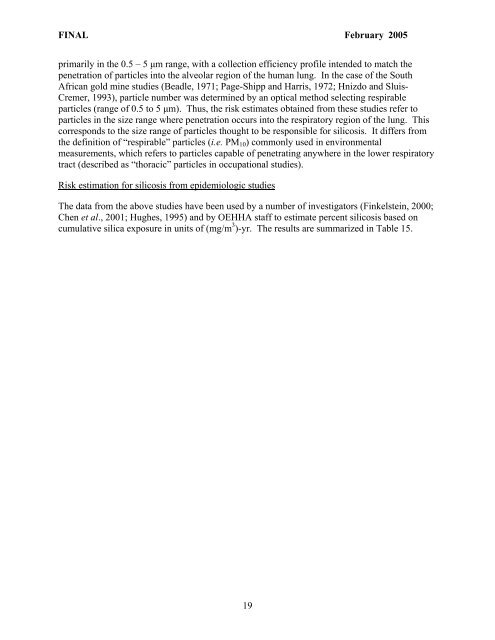Silica (crystalline, respirable) - OEHHA
Silica (crystalline, respirable) - OEHHA
Silica (crystalline, respirable) - OEHHA
You also want an ePaper? Increase the reach of your titles
YUMPU automatically turns print PDFs into web optimized ePapers that Google loves.
FINAL February 2005<br />
primarily in the 0.5 – 5 µm range, with a collection efficiency profile intended to match the<br />
penetration of particles into the alveolar region of the human lung. In the case of the South<br />
African gold mine studies (Beadle, 1971; Page-Shipp and Harris, 1972; Hnizdo and Sluis-<br />
Cremer, 1993), particle number was determined by an optical method selecting <strong>respirable</strong><br />
particles (range of 0.5 to 5 µm). Thus, the risk estimates obtained from these studies refer to<br />
particles in the size range where penetration occurs into the respiratory region of the lung. This<br />
corresponds to the size range of particles thought to be responsible for silicosis. It differs from<br />
the definition of “<strong>respirable</strong>” particles (i.e. PM10) commonly used in environmental<br />
measurements, which refers to particles capable of penetrating anywhere in the lower respiratory<br />
tract (described as “thoracic” particles in occupational studies).<br />
Risk estimation for silicosis from epidemiologic studies<br />
The data from the above studies have been used by a number of investigators (Finkelstein, 2000;<br />
Chen et al., 2001; Hughes, 1995) and by <strong>OEHHA</strong> staff to estimate percent silicosis based on<br />
cumulative silica exposure in units of (mg/m 3 )-yr. The results are summarized in Table 15.<br />
19















